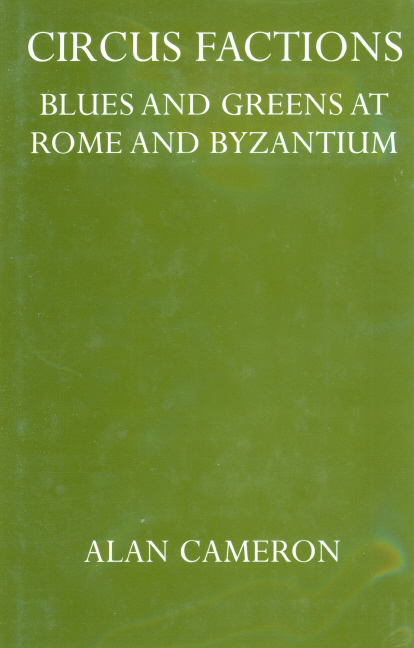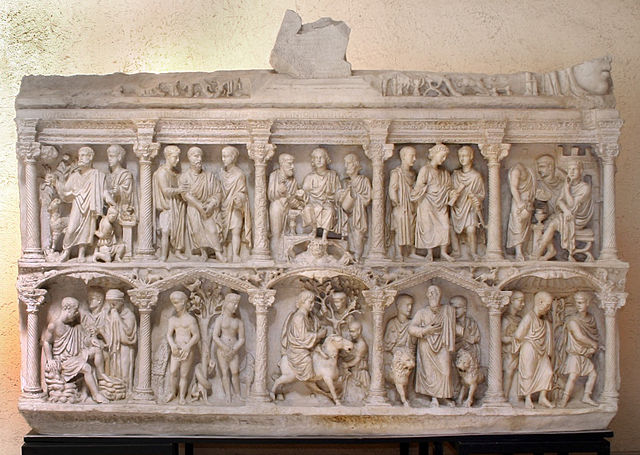
Alan Cameron (born 1938) is a classical scholar from the
**
Porphyrius the Charioteer (1973, reprinted 1999)
** Circus
Factions: Blues and Greens at Rome Constantinople (1976, reprinted 1999)
**
Barbarians and Politics at the Court of Arcadius (1993)
** The Last
Pagans of Rome (hardcover 2011, paperback 2013)
Circus Factions is a sequel to Porphyrius. Like Porphyrius, it is an academic work: most quotations are given in the original language – Greek, Latin, and French – and most of them are not translated into English. Several sections are given to questions of terminology. They are, as Cameron says, “not always easy reading, but inescapably relevant.” The author assumes the reader has a basic knowledge of Roman and Byzantine history. Therefore this book is not recommended for the beginner.
If, on the
other hand, you are already familiar with the history of the ancient world and
you wish to learn more, then this could be the right book for you. When you
read it, you will get a chance to see a meticulous and thorough scholar at
work.
Cameron knows
his topic very well (the ancient evidence and the relevant modern scholarship).
He has no mercy for modern scholars whose works are based on wishful thinking. In
the preface, a volume published by a French scholar in 1968 is described as “a
book whose spectacular marriage of traditional falsehood with original fantasy
has put it beyond the reach of ordinary criticism.”
When a key
statement from this book is presented on page 134, Cameron simply adds a
footnote where he says: “Detailed refutation of each item will not be
necessary; it will be enough to point out that there is not one single scrap of
ancient evidence for any of these attributions.”
The term “circus
faction” is a modern construction. It is not used in any ancient text that we
have, as Cameron points out on page 14, but he decided to use it anyway,
because it is convenient and practical.
There were
four factions in the world of ancient Rome Constantinople , each of them identified by a
colour: Reds, Whites, Blues and Greens. Of the four factions, the Blues and the
Greens were relatively large, while the Reds and the Whites were relatively
small. As for the two large factions, it seems the Greens were more numerous
than the Blues.
What about
the emperors? We know the preference of several emperors: Caligula (also known
as Gajus), Nero, Domitian, Lucius Verus, Commodus, Elagabalus, and Theodosius
II all supported the Greens; Vitellius, Caracalla, and Justinian I supported
the Blues; while Anastasius supported the Reds (pp. 54 and 71).
What about
the charioteers? We have the names of several drivers and some information
about their careers, mainly based on inscriptions on tombstones and statue
bases (page 11, note 6):
* Diocles
won 1,462 times
* Flavius
Scorpus won 2,048 times* Liber won 3,000 times
* Pompeius Muclosus won 3,559 times
The famous
charioteer Publius Aelius Gutta Calpurnianus (who won 1,227 times) is mentioned
as "Gutta" on page 202 (note 4).
Sometimes,
if a driver had a long and successful career, he would change from one colour
to another, but we do not know how often this happened. Regarding this issue, Cameron
says, “the successful charioteer (like the successful footballer today) seems
to have been … free to change colours … if the offers were forthcoming and he
himself was willing.”
For
information about Porphyrius, perhaps the most popular driver of them all, go
to Porphyrius the Charioteer.
Circus Factions
is not so much about the drivers and the races; it is more about the fans of
the drivers and the role they played in ancient history (in the circus and
outside). The book is divided into two parts and twelve chapters. The first
part of the book (chapters I-VI) is devoted to a point by point examination (and
rebuttal) of the previous scholarship on the topic, referred to as the
traditional or conventional view.
According
to the traditional view, the Blues were upper class, while the Greens were lower
class, i.e. there was a social and economic conflict between them (chapter IV).
According to the traditional view, the Blues were orthodox (Chalcedonians),
while the Greens were Monophysites, i.e. there was a religious conflict between
them (chapter VI).
Cameron
insists, again and again, that the traditional or conventional point of view is
not true, for two reasons: (a) it is not supported by any part of the ancient
evidence that we have; (b) it is contradicted by all the ancient evidence that
we have.
In the
second part of the book (chapters VII-XII) Cameron presents his own view of the
circus factions and the role that they played in the history of the Roman and
the Byzantine Empires. This view is firmly based on the ancient evidence.
The first
part is mostly destructive, as you can see from the above, while the second
part is more constructive. In his preface, Cameron says many readers “may
prefer to begin with the positive rather than the negative.”
What about
illustrations? There is only one illustration in this book: a picture of a
circus programme from the sixth century, discovered in the Egyptian town
Oxyrhynchus, is printed on the frontispiece. It is mentioned in the text on pp.
213-214. Today this document is available online: the official reference is Ox.Pap. vol. XXXIV # 2707.
A few
ancient images are mentioned in the text, but none of them is shown in the
book. One example appears on page 62, where Cameron mentions the famous opus
sectile wall mosaic from the basilica of Junius Annius Bassus (consul 331):
“On
each side behind the consul standing in his chariot are two horsemen in
appropriately coloured jackets, Red and Blue to the left, Green and White to
the right.”
[Today this
polychrome item is placed in Palazzo Massimo alle Terme in Rome

This picture (borrowed from Wikimedia) shows the famous opus sectile
wall mosaic from the basilica of Junius Bassus (consul 331).
[Junius Bassus (consul 331) is the father of Junius Bassus (praefectus urbi 359), whose sarcophagus was discovered in 1597. For more information about this magnificent archaeological item, see The Iconography of the Sarcophagus of Junius Bassus by Elizabeth Struthers Malbon (1992).]

This picture (borrowed from Wikimedia) shows the famous sarcophagus of
Junius Bassus (praefectus urbi 359).
The circus
factions were involved in several violent episodes. The most well-known is the
Nika Revolt, which took place in Constantinople in 532. This episode is covered in
the text (pp. 277-280), while additional evidence is presented in appendix C
(pp. 318-333).
Cameron’s
book is based on a wide range of sources, including curse tablets, which are
mentioned several times (pp. 56, 61-62, 194, and 200). A footnote refers to a book
that was published in 1904: Defixionum Tabellae, written in Latin by the
French scholar Auguste Audollent (today this huge volume is available online).
A recent work on this topic is Curse Tablets and Binding Spells from the
Ancient World edited by John Gager (1999).
As stated
above, Circus Factions is an academic work. It is not an easy read. But if
you persevere, you will learn a lot about an interesting and important aspect
of the Roman and Byzantine Empires.
PS. The
following works appeared after Cameron’s book was published: Roman Circuses: Arenas for Chariot Racing by John Humphrey (new edition, 1992); Chariot Racing in the Roman Empire by
Fik Meijer (2010); and Life, Death, and Entertainment in the Roman Empire edited by David Potter and David
Mattingly (second edition, 2010).
* * *
Alan Cameron,
Circus Factions: Blues and Greens at Rome and Constantinople,
Oxford University Press 1976, reprinted by Sandpiper Books 1999, 364 pages
* * *
No comments:
Post a Comment